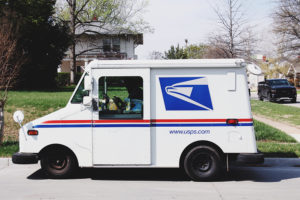Through Rain, Sleet, Hail, and the November Elections?
 Photo by Pope Moysuh on Unsplash
Photo by Pope Moysuh on Unsplash Election years always bring a whirlwind of news, debate, and weeding out truth from falsehood. This election year voters are even more bombarded as they deal with the reevaluation of race in America and how systemic racism negatively effects disenfranchised communities (including access to voting) along with worries associated with COVID-19, including how to avoid the virus while casting their vote in November. Regardless of where one stands on the issues, most Americans can agree on wanting their vote, cast in person or via mail, to count.
And now, as turmoil surrounding the United States Postal Service (USPS) has come to the forefront, many voters are asking if it’s possible their mail-in ballots might not be counted. Ignoring for the moment the president’s suggestion yesterday that people vote twice—by mail and then in person—how exactly did we get here?
Funding
In a statement released in July, Postmaster General Louis DeJoy stated:
The Postal Service is in a financially unsustainable position, stemming from substantial declines in mail volume, and a broken business model. We are currently unable to balance our costs with available funding sources to fulfill both our universal service mission and other legal obligations. Because of this, the Postal Service has experienced over a decade of financial losses, with no end in sight, and we face an impending liquidity crisis.
Under the Postal Reorganization Act of 1970, the USPS was established as an independent government agency, eliminating any dependence on taxpayer dollars and requiring the postal service to generate revenue to cover operational costs.
The USPS’s financial woes seem to have compounded after they were required to prefund retirement and health benefits for current and retired employees under the Postal Enhancement and Accountability Act of 2006. The USPS website says the postal service generates approximately $236 million a day in revenue, and yet it has been operating at a loss for at least thirteen consecutive years. Matters are made worse by a sharp drop in mail volume during the coronavirus pandemic. According to DeJoy, the postal service is losing $10 billion a year.
The Federal News Network reports that without government intervention the USPS projects it will run out of money in 2021, regardless of whether pre-pandemic revenue is restored. Budget cuts that have disrupted the processing of mail add to doubts that the USPS can handle a flood of election mail in a timely manner.
Internal Changes
On May 6 USPS announced that DeJoy had been appointed as the seventy-fifth Postmaster General with a start date of June 15. Since then DeJoy, a candidate handpicked by Robert M. Duncan (chairman of the Postal Service board of governors) who has no prior postal experience and is connected to a company that does business with USPS, has implemented controversial changes. Some of those changes, widely reported of late, include removing mail sorting machines, removing curbside mailboxes, eliminating overtime, and halting late delivery trips, all of which have resulted in mail delays and a fear that the USPS doesn’t have the resources available to handle what may be the largest by-mail vote in US history.
DeJoy recently appeared before the House Oversight Committee, which has since issued a subpoena to obtain documents showing the communication between the USPS and the White House among other things. Many of those who questioned DeJoy criticized the changes as “incompetent” and an attempt to interfere with the counting of thousands of mail-in ballots for the November presidential election. As reported by the New York Times, DeJoy denied letting his personal political interests interfere with his position at the helm of the USPS and defended his changes as much-needed budget cuts, some of which were put in process by his predecessor.
What Can Voters Do?
Following the news on everything happening with the USPS doesn’t exactly instill confidence, however there are some things that voters can do:
- Request your ballot as soon as possible but at least fifteen days prior to the election date. Some places like Washington, DC, are sending mail-in ballots to all active voters, while states like Maryland require voters to request a ballot.
- Know your state’s voting deadline and mail your ballot at least 7 days prior.
- Familiarize yourself with standard delivery and collection times in your area.
- Instead of mailing your ballot, drop it off at the supervisor of elections office or other secure ballot drop off locations in your city.
- Don’t vote twice! Doing so intentionally is illegal and in some states a felony.
- Don’t procrastinate! The best way to ensure your vote is counted is to act early.
For more information please visit https://www.usa.gov/election-office and https://about.usps.com/what/government-services/election-mail/.
